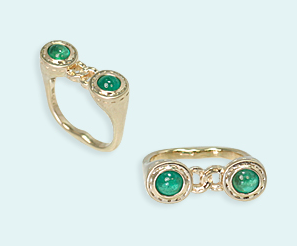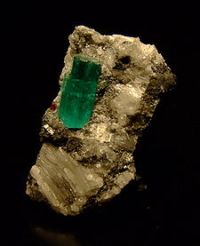
What sort of emotions are elicited by the word “emerald?” A stunningly saturated color of green could be envisioned. Perhaps the precious gems, commonly held to be among the most valuable in the world, could be called to mind…or one may even be transported to the “Emerald Isle” of Ireland and hear a distant melody of “Danny Boy” playing wistfully in their ears. The emerald is held in such high regard for the serenity that it can bring that Roman historian Pliny the Elder even spoke of the healing power that the gem held for ancient lapidaries who “[had] no better method of restoring their eyes than by looking at the emerald, its soft, green color comforting and removing their weariness and lassitude.”
For such a tranquil stone, it is amazing how it can still hold such power to excite powerful emotion! This gorgeous, green-hued variety of beryl caused quite a stir, for instance, when the notorious conquistador Cortez brought home a supply of emeralds from the ‘New World’ where they existed in abundance. The most magnificent emerald of the hoard was engraved with the words “among those born of women, a greater has not arisen,” which he intended to give to his bride as a fitting wedding present.  This fortune, however, was perhaps not so fortuitous; historians maintain that the Spanish Queen was so disappointed that she was not the recipient of these gems that she became his enemy for life! The historian Brantôme even claimed that it was a sacrilege to engrave upon the face of any material so beautiful, and Cortez’ perceived comeuppance for this atrocity included the loss of a pearl of unparalleled magnificence, so lovely that he composed “A Beautiful and Incomparable Pearl” in its honor, the loss of this entire horde in a shipwreck, and even the death of King Charles IX of France.
This fortune, however, was perhaps not so fortuitous; historians maintain that the Spanish Queen was so disappointed that she was not the recipient of these gems that she became his enemy for life! The historian Brantôme even claimed that it was a sacrilege to engrave upon the face of any material so beautiful, and Cortez’ perceived comeuppance for this atrocity included the loss of a pearl of unparalleled magnificence, so lovely that he composed “A Beautiful and Incomparable Pearl” in its honor, the loss of this entire horde in a shipwreck, and even the death of King Charles IX of France.

Despite this loss of wealth for Cortez, earlier sources had made the obvious mental jump between emeralds and the verdant green of wealth…According to one ancient recipe for tinctura smaragdi, or ‘tincture of emerald,’ “the occult power of the gem was supposed to be greatly increased by engraving on it a proper astrological device. Ancient ‘authorities’ state that ‘men like a merchant, carrying wares to sell, or men seated under a centurian engraved on an emerald, gives wealth and victory, and delivers from evil.’ For any pagan practitioners less interested in the material world and more in the spiritual, simply applying “a hoopoe with the herb-dragon in front, upon beryl, hath the power to summon the water-spirits and force them to speak. It will also call up the dead of your acquaintance, and oblige them to respond to your questions.”
For those of you who are comfortable keeping more of a long-distance friendship with the deceased, but just want to look like Angelina Jolie strutting down the red carpet in magnificent emeralds (her favorite ), never fear! Emeralds can come from just about anyplace in the world, with the ironic exception of Ireland. A famous Egyptian source known as “Cleopatra’s Mines,” though only slim pickings of emeralds remain there today, were known to have once produced a generous abundance of emeralds that lasted over three thousand years! These mines were likely responsible for the bulk of Rome’s abundance of emeralds during the height of its opulent reign. But, dear reader, rather than turn green with envy at all of these famous gems of the past…why not simply carry home a precious little (or big) emerald of your own?
), never fear! Emeralds can come from just about anyplace in the world, with the ironic exception of Ireland. A famous Egyptian source known as “Cleopatra’s Mines,” though only slim pickings of emeralds remain there today, were known to have once produced a generous abundance of emeralds that lasted over three thousand years! These mines were likely responsible for the bulk of Rome’s abundance of emeralds during the height of its opulent reign. But, dear reader, rather than turn green with envy at all of these famous gems of the past…why not simply carry home a precious little (or big) emerald of your own?
Still want to know more about emeralds? We hear you! Click over to Eve’s previous post on the May birthstone, Romancing the Stone, to get your gemstone fix!




 emotional. You see the first part: a tempus fugit.
emotional. You see the first part: a tempus fugit.
 A: There will be some things that perhaps Pompeii would not have seen. Maybe black diamonds were very rare, or occasional there, more than they are now. But in the second part, one of the pieces of shorthand that I’ve used (as the Romans did) are intaglios and carved figures. For these, the designs will often be negatives, not positives. They will be shown in reverse, because we are going backwards through time from the present. They will be seen through other gems, because that is what one sees: you see things through a glass. There will be a number of pieces like this: where antiquity is present, but not directly. You’ll see it a remove or two…one remove is by seeing only the reverse of the scenes, the other one is in seeing them through a barrier.
A: There will be some things that perhaps Pompeii would not have seen. Maybe black diamonds were very rare, or occasional there, more than they are now. But in the second part, one of the pieces of shorthand that I’ve used (as the Romans did) are intaglios and carved figures. For these, the designs will often be negatives, not positives. They will be shown in reverse, because we are going backwards through time from the present. They will be seen through other gems, because that is what one sees: you see things through a glass. There will be a number of pieces like this: where antiquity is present, but not directly. You’ll see it a remove or two…one remove is by seeing only the reverse of the scenes, the other one is in seeing them through a barrier.



You must be logged in to post a comment.